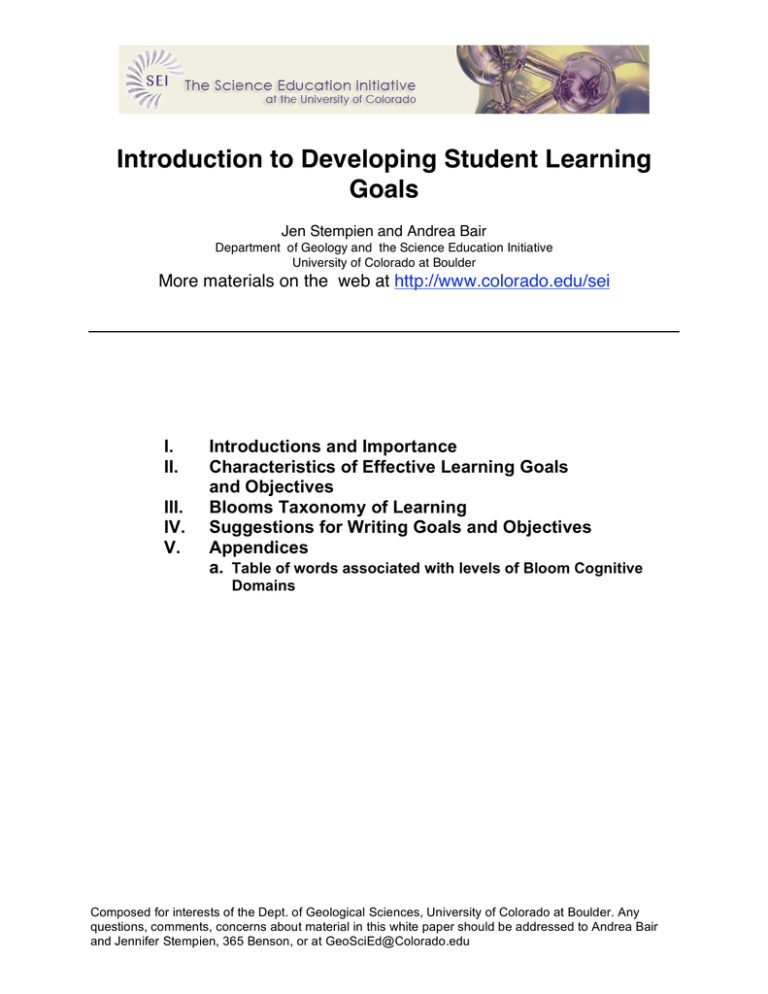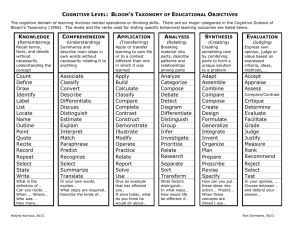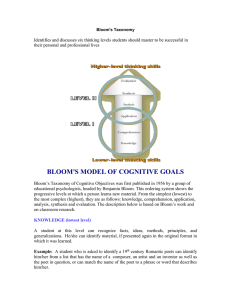An introduction to writing student learning goals
advertisement

Introduction to Developing Student Learning Goals Jen Stempien and Andrea Bair Department of Geology and the Science Education Initiative University of Colorado at Boulder More materials on the web at http://www.colorado.edu/sei I. II. III. IV. V. Introductions and Importance Characteristics of Effective Learning Goals and Objectives Blooms Taxonomy of Learning Suggestions for Writing Goals and Objectives Appendices a. Table of words associated with levels of Bloom Cognitive Domains Composed for interests of the Dept. of Geological Sciences, University of Colorado at Boulder. Any questions, comments, concerns about material in this white paper should be addressed to Andrea Bair and Jennifer Stempien, 365 Benson, or at GeoSciEd@Colorado.edu I. Introduction and Importance Why is it important to think about learning goals? There are many interconnected methods, approaches and outcomes in teaching. It is beneficial to consider the desired educational outcomes of a course first to determine the appropriate approach to achieve them, and to communicate these ideas and goals to the students. For the student o o o Helps student by making them aware where they stand- self assessment Tell student what is expected from them and at what level – promote student responsibility for own learning Makes clear to student what they can gain from a particular course/lecture For the instructor o o o o Plan content and appropriate teaching/learning strategy Design effective material (homework/ inlecture activities) by acting on a template Set a blueprint for design and use appropriate exams and assessments Informs students and colleagues what a particular course/activity is to achieve (Modified from Jenkins & Unwin, 1996; Harden, 2002; FDI Virginia Tech, 2004) What are Learning Goals? A learning goal is a broad statement of the intended general outcome of an instructional unit or program. (Arreola, 1998). For example: “Students will develop a working understanding of earth’s dynamic nature”. These broad statements are to communicate the concepts that you want students to take away from your class and remember years from now. What is the difference between a Learning Goal and Learning Objective? A GOAL is a statement of general outcome. An OBJECTIVE is a statement referring to specific course content and level of understanding that is expected from the students regarding that material. A Learning objective is one of several specific statements that when achieved contributes to achieving a general goal of the course. A learning objective has three major components (Jenkins and Unwin, 1996; Arreola, 1998): 1. A description of what the student will be able to do – behavior. 2. The conditions under which the student will perform the task - condition 3. The criteria for performance evaluation – measurable criterion. Objective: “Given a set of data the student will be able to compute the standard deviation.” Behavior – Student will be able to computer standard deviation Condition – Given a set of data Criterion (implied) – the number computed will be correct. Introduction to Developing Student Learning Goals December 2006 2 Learning objectives are specific statements that are nested within a goal that describes what are the means to achieve the goal, what is expected the students must do. There are typically 3-5 objectives for each learning goal. Example: Learning Goal: General outcomes Learning Objectives: Specifics to achieve goal Students will be able to define tectonic plates and name the 3 main types of tectonic boundaries Student will examine the evidence supporting movement of Earth’s continents Students will be able to explain how tectonic plates move relative to one another Students will be able to demonstrate how the earth’s magnetic field can be used to define geographic location Students will be able to determine the movement of continents through time II. Characteristics of Effective Learning Goals and Objectives (FDI, Virginia Tech 2004). Student focused rather than instructor focused. o Should answer the following questions: o What will my student know? o What will they understand? o What will they be able to do at the end of instruction? o Should NOT be stated in terms of what subject matter that will be presented or covered during a course. Stating only what subject matter that will be presented is not as helpful in designing effective learner – centered instructional methods, strategies, and appropriate assessments Focus on the learning that results from an activity not the activity itself Should state the outcome of an instructional activity not the activity itself. For example: o o “Student will compose an essay on plate tectonics” - just states an activity “Student will compose an essay detailing the evidence used to support the theory plate tectonics” - emphasizes the outcome of the activity in addition to the activity itself. Focus on the important aspects of learning – see Bloom’s Taxonomy It can be easy to fall into writing “Jeopardy”- type questions; questions that focus only on easy-to-measure, relatively unimportant outcomes such as recalling facts. Introduction to Developing Student Learning Goals December 2006 3 Recalling facts are usually useful only when a person can them use them effectively to make decisions and solve problems III. Bloom’s Taxonomy for Learning There are three aspects of learning used to define what learners think, do, and feel. In science education the focus is on what students think, also known as the cognitive domain. Bloom (1956) represented the cognitive domain into six taxonomic levels where lower level represented a lower cognitive state and is a prerequisite to those above. So before an individual can evaluate a situation (the highest cognitive level) they must (1) have factual knowledge of the situation, (2) comprehend what that knowledge means, (3) be comfortable enough with the comprehension so that it can applied in other situations, (4) analyze its parts, and (5) be able to synthesize the parts into new patterns and ideas (FDI, Virginia Tech, 2004). Bloom’s Cognitive Domain Learning Objectives Knowledge Lowest Level Comprehension Remembering/recalling terms facts, definitions, etc. Knowing what a term, fact, concept, statement, etc. means. Application Using what has been previously learned in a new situation Analysis Breaking down a whole into its parts Synthesis Evaluation Highest Level Assembling a whole from its parts Making judgments based upon specific criteria The implications are for students to learn/perform at higher cognitive levels, they have to be comfortable working at lower levels. Well-constructed learning objectives for a goal should guide students from lower cognitive levels to high ones, not just have an automatic jump to the highest level. Example: Learning Goal: General outcomes Learning Objectives: Specifics to achieve goal Student will examine the evidence supporting movement of Earth’s continents Students will be able to define tectonic plates and name the 3 main types of tectonic boundaries Students will be able to explain how tectonic plates move relative to one another Students will be able to demonstrate how the earth’s magnetic field can be used to define geographic location Students will be able to determine the movement of continents through time Introduction to Developing Student Learning Goals Cognitive Domain Knowledge Lower Level Comprehension Application Analysis Higher level December 2006 4 IV. Suggestions for writing How many goals and objectives should a course have? There is no prescribed number of learning goals and objectives for a course, the exact number will depend on the desired learning outcomes. Below are some suggested amounts based on a survey of science and math courses that use learning goals and objectives. Course Learning Goals (5-10 per course) Course learning goals are general goals that describe what are the most important concepts/big pictures for that specific course. Think about what you want your students to remember about this course five years from now. Course learning goals are the first goals that students will read for the course and need to be as “lingo-free” as possible so that they understand what can be expected in the course without having any prior knowledge of the material. Topic Learning Goals (1-5 per topic; 5-50 per course) Topic learning goals are general goals that refer to certain themes/topics in a course, for example plate tectonics or igneous rocks and the ultimate learning level that students are to achieve in that topic. The topic learning goals should work to achieve the broader course learning goals. Topic learning goals should be as lingo-free as possible, though since they refer to topics some subject terms may have to be used. There may be multiple topic learning goals that achieve a course learning goal. Lecture Learning Objectives (3-5 per lecture; 3-25 per topic) Learning objectives are specific statements that refer to certain content and the level of understanding that students need to perform at to ultimately achieve topic and course level goals. Learning objectives will have the most lingo, especially if it is necessary for students to be familiar with terminology used in the course. However students/nongeologists should still be able to understand what is expected from them, regardless of course-specific terminology Writing learning outcomes Step 1: Articulate your student learning goals (the broad general statements). Some suggestions on how to think about these: o What are your goals for the class? Introduction to Developing Student Learning Goals December 2006 5 What are the big ideas about the subject in questions that you think students should remember a year after completing the course? For example having a student remember that there are different magma compositions when they hear a news story about a volcanic explosion. A common concern is that certain goal statements are difficult or impossible to measure. This is okay, remember that the nested learning objectives will articulate to the students the measurable outcomes. Some people will find it easier to write the course learning goals first, others will find it easier to write the topic learning goals first. o Step 2: Articulating learning objectives: o What are measurable outcomes? (How do I plan to test for this?) o What do I want the student to be able to do, specifically? o If there is a learning objective that is at a high cognitive level, are there learning objectives that cover the prerequisite lower cognitive levels? o Does the learning objective link to only one learning goal? Is the link between learning objective(s) and their respective learning goals clear? Remember: When first attempting to compose learning objectives, start with the behavior (what you want the student to be able to do and at what level). The other two components, condition and criterion, relate to teaching strategies and assessments that are dependant on the behavior specified, and will be easier to determine later. Step 3: Revise, revise, revise! It will take multiple revisions before learning goals and objectives will develop that best articulate your goals as an instructor. With each revision the learning goals and objectives will become more specific and clear, especially to individuals who are not geologists. It will also take multiple semesters to determine the levels of cognition that students are able to achieve on certain topics. Suggestions: After a day or two re-read your goals. Do they still seem clear to you? What should students now be able to do as a result of reading it? o Are there active words in the goal/objective? (see pg. 7) o After you used the learning goal/objective, did the student perform to the level that was expected of them? o Try to write each objective/goal in ten different ways, for each iteration reduce the amount of geology terminology and increasing the clarity of what level is expected from student. o Ask a colleague who is not a geologist whether they know what is expected of them o Introduction to Developing Student Learning Goals December 2006 6 TABLE OF WORDS ASSOCIATED WITH LEVELS OF BLOOM COGNITIVE DOMAINS. Information- Oriented Knowledge: To remember, recall, or memorize terms, facts, definition etc. Suggested Verbs Assess by direct questions. The object is to test the student’s ability to recall facts, to identify and repeat the information provided Acquire Arrange Define Distinguish Duplicate Process - Oriented Comprehension: Knowing what a message (term, fact, concept, statement) means Application: Applying or use information in a new situation Analysis: Examine a concept and break it down into it parts Synthesis: Assembling a whole from parts to solve a problem Evaluation: making judgments based on specific criteria Identify Label Match Memorize Name Recall Recognize Repeat Reproduce Suggested Verbs Assess by having students’ 1) restate material in their own words, 2) reorder or extrapolate ideas, predict or estimate. May provide evidence that the students have some understanding of what they are saying. Abstract Classify Convert Describe Discuss Explain Extrapolate Identify Indicate Interpret Locate Recognize Restate Sort Assess by presenting students with a unique situation (i.e. not identical to that used during instruction) and have them apply their knowledge to solve the problem or execute the proper procedure Apply Carry out Choose Demonstrate Dramatize Explain Analyze Appraise Breakdown Calculate Catalog Classify Compare Contrast Criticize Arrange Assemble Build Compose Construct Create Generalize Illustrate Interpret Operate Plan Prepare Detect Determine Diagram Differentiate Discover Discriminate Distinguish Estimate Examine Design Formulate Integrate Manage Organize Plan Appraise Argue Assess Check Estimate Evaluate Judge Measure Predict Rank Rate Score Assess by presenting students with a unique situation of the same time type used in instruction and have them analyze the situate and describe the appropriate procedure or solution to the problem Assess by presenting a unique situation and have them solve a problem by selecting and using appropriate information Assess by presenting the students with a situation which includes both a problem and a solution to the problem and have them justify or critique the solution Introduction to Developing Student Learning Goals Tell Translate Transform Repair Schedule Sequence Solve Use Explore Identify Investigate Observe Order Question Recognize Test Produce Propose Specify Synthesis Systematize Theorize Write Select Support Test Value Verify December 2006 7 References Cited Arreola, R.A. 1998. Writing Learning Objectives. in Arreola, R.A. and Aleamoni, L.M. Assessing Student Learning Outcomes: A Workshop Resource Document. University of Tennessee, Memphis. Bloom B. S. (1956). Taxonomy of Educational Objectives, Handbook I: The Cognitive Domain. New York: David McKay Co Inc. Faculty Development Institute, Virginia Tech (2004) Unit 2: Develop Student Learning Goals. [https://www.fdi.vt.edu/summer/2004/Content/TrackG/Unit2/default.html] – accessed Dec 5, 2006. Harden, R.M. (2002) Developments in Outcome-Based Education. Medical Teacher. 24(2) pp. 117-120. Jenkins, A. and Unwin, D. (1996) How to Write Learning Outcomes. [http://www.ncgia.ucsb.edu/education/curricula/giscc/units/format/outcomes.html] – accessed Dec. 5, 2006. Introduction to Developing Student Learning Goals December 2006 8 FCQ’s and Critisism. 1. Learning goals cannot predict what students learn. 2. Learning goals are just another what to enfore standard or social expectation on students • ome groups in the USA object to them as aiding education as social engineering. 3. • Some instructors say, with justification, that they can't predict what students will learn. Hence the use of the word 'intended'. 4. How do can I be sure of the effectiveness of learning goals 5. What is the best method to distribute learning goals to the students 6. Introduction to Developing Student Learning Goals December 2006 9




